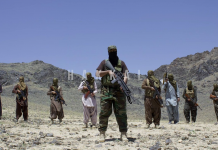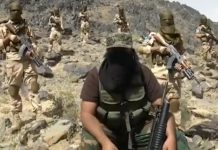
Siachen: More than a week after the 40th anniversary of ‘Operation Meghdoot’, Indian Defence Minister Rajnath Singh today visited Siachen region and hailed the valour of the country’s military which foiled Pakistan’s sinister design of occupying the strategically-located ice-clad mountain passes in April 1984.
India had on April 13, 1984, pre-empted Pakistan by swiftly moving its troops to the Saltoro Ridge, which is located at an altitude of over 25,000 feet and was till then an unoccupied region, left out in the Simla Agreement of 1972.
Thus, came into being a de-facto 110-km long boundary called ‘Actual Ground Position Line (AGPL)’ which extends northwards from Point NJ 9842, where LoC ends, up to Indira Point, a tri-junction of India, Pakistan and China.
In the Simla Agreement of 1972, India and Pakistan determined their un-demarcated de-facto border in Jammu and Kashmir, then including Ladakh. It was called the ‘Line of Control (LoC)’, a rename of the ‘Ceasefire Line’ which existed since 1949.
Interestingly, the LoC was demarcated from Jammu region northwards only up to Point NJ 9842 in Ladakh and rest of the huge mass of land beyond was left un-determined because it was considered ‘too inhospitable’.
It was thought that nobody would be able to occupy and stay put in the area which perennially remains covered with a massive amount of Glacier and snow, with temperature ranging below minus up to minus 50.
The area remained undisputed for some years.
But in the early 1980s, Pakistan began showing this territory as its own in its country map.
Along with this, intelligence inputs were received in New Delhi that Pakistan was shopping for high altitude gears in the international markets for possible use in the Saltoro Ridge area.
Pakistan also started sending some groups of people to this area under the garb of ‘Mountaineering Expedition.
In view of such developments, the Indian government was convinced that Pakistan was up to some sinister design and the then Prime Minister Indira Gandhi ordered the Indian military to immediately rush to the Saltoro Ridge to occupy the strategic heights and passes there.
Accordingly, the first units of the Indian Army were rushed by the Indian Air Force to Saltoro Ridge under the Operation codenamed ‘Meghdoot’.
The first units mostly comprised soldiers hailing from the mountainous parts of Uttarakhand (then part of Uttar Pradesh) who knew such inhospitable areas well.
This quick Indian decision and action pre-empted Pakistan, which also rushed its troops to the region but it was late as the Indian army had already taken control of the dominating heights and strategic passes.
A bloody confrontation ensued as the Pakistan Army tried to evict the Indian troops from the dominating positions. The Pakistan Army managed to capture only one key position which it named as ‘Quaid Post’ after their Father of the Nation Mohd Ali Jinnah.
In 1987, the Indian troops dislodged the Pakistani soldiers from this post too after a bloody battle which became historic because of the exemplary heroic action by Naib Subedar Bana Singh. He was later promoted as Captain and honoured with Paramvir Chakra, the highest gallantry award.
Since then, a humiliated Pakistan has tried, at regular intervals, to dislodge the Indian troops from that inhospitable area but it has failed every time.
The region has witnessed numerous military clashes between India and Pakistan, thus gaining the title of ‘The World’s Highest Battlefield’.
Defence Minister Rajnath Singh today described this battlefield as “the capital of valour and courage” of the Indian military.
Addressing the troops at Siachen, he hailed the Indian soldiers for the “way you protect the country at the world’s highest battlefield” and said the soldiers serving the nation are no less than the ‘devtas’ (deities) for the people of India.
Accompanied by Army Chief Gen Manoj Pande, Singh underlined that Siachen is not an ordinary piece of land but “a symbol of the country’s sovereignty and perseverance”.
“Siachen represents our national determination. Our national capital is Delhi, Mumbai is our economic capital, our technological capital is Bengaluru, but Siachen is our capital of valour and courage,” the Defence Minister said.
Referring to the 40th anniversary of ‘Operation Meghdoot’, he said, “On April 13, 1984, the Indian Army carried out such a military operation which is cited as an example in the world today. Operation Meghdoot is such a golden chapter in Indian military history that has been thrilling every Indian for the last four decades.”
He said the success of ‘Operation Meghdoot’ in Siachen is a matter of pride for all Indians.
Observing that the Indian Army is always ready to protect the borders of the nation, the Defence Minister told the soldiers at Siachen, “Your love for the nation serves as an inspiration for all of us Indians…. I salute from my heart all the brave soldiers deployed on Siachen Glacier to protect the motherland. I salute your immense love for the nation.”







